First published in Anchor Point, Vol. 16, No. 5, May 2002.
Reprinted in Rapport, Issue 45, Autumn 2002.
A man walks into a psychotherapist’s office. The therapist asks:
“And what would you like to have happen?”
The client replies:
“I want to stop going into blank.”
No, this is not the beginning of a joke, this is a real client and these are his exact words. If you were the therapist, what would you be thinking and feeling? What would you be considering before you reply to this client? And then, what specifically would you respond?
This article describes a model for a way of thinking during those few seconds when you are pondering what the client has just said. It describes a way of modelling in the moment a way to ensure that what you decide to say is maximally informed by the client’s information.
Rather than give a theoretical explanation, we will use the above example to show how we muse in practice. First we will unpack the client’s statement to demonstrate just how much information can be extracted from a seven-word sentence. As we do this, we will construct a prototype model of the client’s model of the world, staying as faithful as possible to the exact formulation of: “I want to stop going into blank.” Then we will describe how we responded to his statement, and why. Our purpose in taking you through our internal process is to help you enhance your ability to construct an in-the-moment model of the inferential logic in a client’s words.
Loitering on a Thought
Like most verbs, ‘to muse’ had a metaphorical beginning. According to Webster’s Dictionary its Latin derivation was “to stand with muzzle in the air” and later it came to mean “to loiter.” In an ancient Indo-European language, however, ‘to muse’ originally meant “to pay attention to.” By the time it entered the Greek language it had come to mean the “source of genius or inspiration.” So you can see how today’s meaning combines these etymologies: to gaze up, loitering on a thought, while waiting for inspiration.
To ‘ponder’, on the other hand, comes from the Latin “to weigh” and hence its current metaphorical extension: “to weigh mentally; think deeply about; consider carefully.” We will use musing and pondering interchangeably.
Intelligence Between the Lines
Several years ago the originator of Clean Language and one of the world’s most innovative psychotherapists, David Grove, introduced us to ‘musing’. During demonstrations of his approach David often pauses and muses to the audience about what the client has just said. Although this occasional musing out loud is part of his training method, he also muses to himself during the natural pauses in a therapy session, particularly when the client is deep in thought.
In modelling David Grove’s thought processes, we discovered that he muses to make explicit (to himself) what is implicit in the logic of the client’s words and nonverbal behavior. He does this by continually reviewing information the client has presented, paying special attention to their exact words, gestures and lines of sight, with the aim of discerning, as he puts it, the “intelligence between the lines.” As we see it, his musing, pondering, ruminating, thinking over/around/about is a way of constructing a model of the organization of the client’s model of the world.
Musing ‘Cleanishly’
During a therapy session, our primary aim is to facilitate the client to self-model; that is, to construct a model or metaphor which describes how they do the things they do. This model will include how things are now [usually a Problem], their proposed solution [Remedy], and their desired outcome [see our PRO model]. As a by-product of facilitating the client to self-model, we construct our model of their model. We do not expect to replicate the client’s map. Instead our aim is to construct a model that is isomorphic with it (has a corresponding organization). We call this process Symbolic Modelling.1
To keep our model of their model ‘clean’, we seek to distinguish between our sensory observations of the client, what we are inferring from those observations, and what is derived from our personal maps. Of course it is impossible to separate these completely as the modelling process requires us to “delete, distort and generalize.”2 But we maintain that the cleaner our model and the more isomorphic it is with the organization of the client’s model, the more we are able to work within their map of the world — and that’s respectful therapy.
We know that what we know is not the same as what the client knows – it is a metaphor for it. And like all metaphors it illuminates some aspects while at the same time hiding others in shadow. As a result, we constantly apply one simple rule: The client is the expert at being themselves. Their description of their model is always more informed than ours, and whenever a piece of information does not fit with our model, then our model needs revising.
Because of this rule, we can construct a model and know it is a prototype (in the sense of ‘first form from which varieties arise’). We know it is just a start, we know it is inaccurate, and we know that as soon as the client provides the next piece of information our model will need updating. And this never stops happening. We never get a complete, finished, accurate model – it is all a matter of degree.
Musing on First Words
While you can muse on any of your client’s statements, we pay particularly close attention to their answer to “And what would like to have happen?” – a request for a desired outcome.
We write down the client’s first words verbatim and repeat them back exactly as they said them, including pauses, unusual grammar, pronunciations, etc.3 Then we pause to consider these words. Doing this has two important effects for the therapist and client:
- It acknowledges the significance of the client’s response and its precise formulation.
- It slows down the start of the modelling process, allowing more time for, as Charles Faulkner says, “the world within a word” to become apparent.4
Example
To illustrate the kinds of musing we engage in, let’s return to the example at the beginning of this article:
T: And what would you like to have happen?
C: I want to stop going into blank.
We start by identifying the metaphors in the client’s statement. Then we consider what can reasonably be presupposed from those metaphors, i.e. what are the background assumptions which are necessary for the representation to make sense. (Quotation marks around the client’s words indicate that everything else derives from our map of the world.)
- There is a state of mind named “blank.”
- There is some other state of mind that is NOT “blank.”
- The client has a way of knowing when there is a change from NOT “blank” to “blank.”
- In “blank” he cannot do what he does when NOT “blank” (or not to the same degree) and presumably for him that is a problem.
- He goes through a sequence of states: NOT “blank” > “going into” > “blank.”
- “Going into” is a process that suggests movement in a direction.
- It is ambiguous whether “I” or something else is “going into blank,” e.g. ‘I want to stop [my mind] going into blank’.
- “Blank” is container-like because something goes “into” it.
- Between “blank” and NOT “blank” is some kind of boundary or threshold. This may be sharp, narrow or digital (and be crossed very quickly); or fuzzy, analogue with degrees of blank and NOT-blank (and take a while to cross).
Examining the client’s metaphors in this way has provided enough information to start constructing a prototype model.5 A visual representation [schema] of our model is shown in Figure 1.
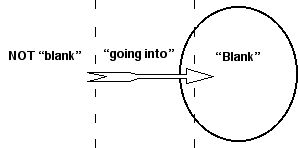
Now let’s examine more of the inherent logic in the client’s statement:
- As “going into” is a process it will have a before, a during, and an after.
- Something
happens that means NOT “blank” is interrupted (see ‘?’ in Figure 2), and this event will also have a before, during, and an after. - The client must have a way of getting out of “blank” and returning to NOT “blank” so that “going into blank” can happen again next time. Therefore “blank” is also a process with a before, during, and after.
- Given the context is therapy, we assume that “going into blank” has not resulted in his system learning to do anything different, i.e. this is a repeating and habitual pattern of behavior: NOT “blank” > “going into” > “blank” > NOT “blank” > “going into” > …
These inferences enable us to create a model of the pattern of the client’s problem. From a systemic viewpoint, it is the nature of the pattern that keeps the behavior repeating (see Figure 2).
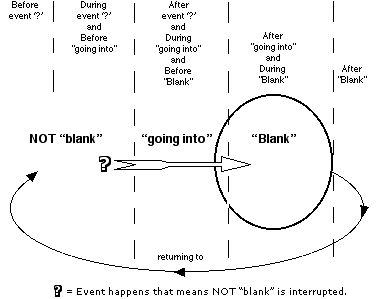
Having modelled the problem, we turn our attention to the client’s proposed solution, “to stop going into blank”:
- “Stop” presupposes a process that inhibits a movement once it has started, or
prevents an impulse from starting to do something. - “Stop” requires some way of noticing that “going into blank” is just about to
happen, so that the stopping process can occur (see the X in Figure 3). - As long as the potential for “going into blank” remains, a process of stopping will be necessary.
Figure 3 shows our model of the client’s proposed solution.
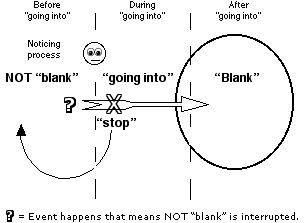
These simple models give us masses of information about how (we think) the client constructs his personal reality. The structural similarity of Figures 2 and 3 indicate that his proposed solution is a more complicated version of the problem. The solution will require him to notice when he is about to go into blank and then enact a stopping process. Even if he achieves his solution, this will not necessarily change the original motivation and impulse for “going into blank.”
In this case we can reword Paul Watzlawick’s famous phrase ‘The solution is the problem’, to say: The solution adds to the problem.6 His solution may well be a useful translation and give him relief from “going into blank,” but because the basic organization of his metaphors has not changed, it is not a transformation.7
What Actually Happened
C: I want to stop going into blank.
T: [Pause] And you “want to stop going into blank.” [Pause] And when you “stop going into blank,” then what happens?
C: I will remain alert and focussed.
First we repeat the client’s exact words, and then we ask a question which incorporates them. Notice how the question directs the client’s attention to a time ”when you stop going into blank” before asking “then what happens?”. Our purpose for asking this question is for the client to identify the effects of having achieved his solution. We do not use the words ‘effects’, ‘achieve’ or ‘solution’ because these are our metaphors and they may not be relevant in the client’s map. And because he does not need to process our metaphors, he is free to attend to his own mindbody perceptions – and to describe them in whatever way he wants. This is an example of using David Grove’s Clean Language.8
The client’s answer indicates that while his problem is “going into blank” and his solution [Remedy] is “to stop” the problem, his desired outcome is to “remain alert and focussed.” As we have new information, our model constructing can go through another iteration (see Figure 4).
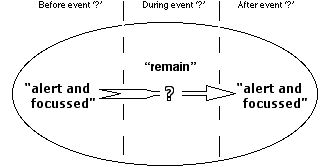
The client’s proposed solution may be all he wants or needs. Or it may be that trying to “stop” the “going into” process will create its own problems. Or perhaps it is an intermediate step towards a more effective way to “remain alert and focussed.” And we are open to the possibility that there are lots of other ways for him to achieve his desired outcome that do not involve a “stop going into” process at all. Neither the client nor us can know what will happen next.
Concluding Remarks
The kind of musing we have described is a way to deconstruct clients’ metaphors so that the inherent logic which resides between the lines can emerge. This enables us to construct a prototype model isomorphic with (a metaphor for) the patterns of the client’s map of the world. In so doing we establish a different kind of therapeutic relationship. We are not client-centered, nor do we ‘go to second position’ with the client. Instead we are client-information-centered and are in rapport with the organization of their metaphors (see Figure 5).
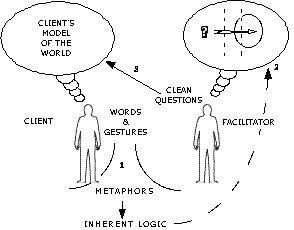
Key:
1 = Deconstructing the client’s information
2 = Constructing an isomorphic model
3 = Directing client’s attention to their symbolic perceptions
Musing and asking clean questions from within the logic of the client’s map facilitates them to self-model. Through Symbolic Modelling the client can identify the metaphors that inform the behaviour of their mindbody system, and in so doing discover their individual way to transform.
Notes
1 See Metaphors in Mind: Transformation through Symbolic Modelling and numerous articles at cleanlanguage.com
2 Richard Bandler and John Grinder, The Structure of Magic I, Science and Behavior Books, Palo Alto CA, 1975, pp. 14-16.
3 Philip Harland has developed a useful way of recording clients’ first words. See The ‘Mirror Model’: A guide to reflective questioning Rapport 42, Winter 1998, pp. 8-16.
Alternatively, you can ask the client to write down their desired outcome themselves. This has the bonus of providing you and them with additional visual and spatial information.
4 Charles Faulkner, The World Within a Word (Audio tape set), Genesis II, Lyons CO, 1999.
5 Note that during the session we were not consciously aware of all of the inferences specified. However, because we have gone through the musing process ‘off line’ many times, we believe that when we are ‘online’ and working live, similar out-of-awareness musings are informing the questions we ask.
6 Paul Watzlawick, Munchhausen’s Pigtail, W.W. Norton & Co, New York, 1990.
7 To paraphrase Ken Wilber (Sex, Ecology, Spirituality, 1995): Systems evolve by “translation” (their form changes but not in a way that significantly affects higher-level patterns), or by “transformation” (a new pattern of organization emerges and the whole system changes into a fundamentally new form).
8 For the 9 basic Clean Language questions see our article Metaphors in Mind: A case study, Anchor Point, Vol. 15, No. 5, May 2001,
Acknowledgements
We presented the ideas in this article to the Symbolic Modelling Developing Group, 1 Dec 2001, and many of the insightful suggestions from that day have been incorporated into the article. Thanks also to Philip Harland for valuable comments on the draft.
For other examples of musing on a metaphor see our articles:
Symbolic Modelling and the Emergence of Background Knowledge
Embodied Schema








